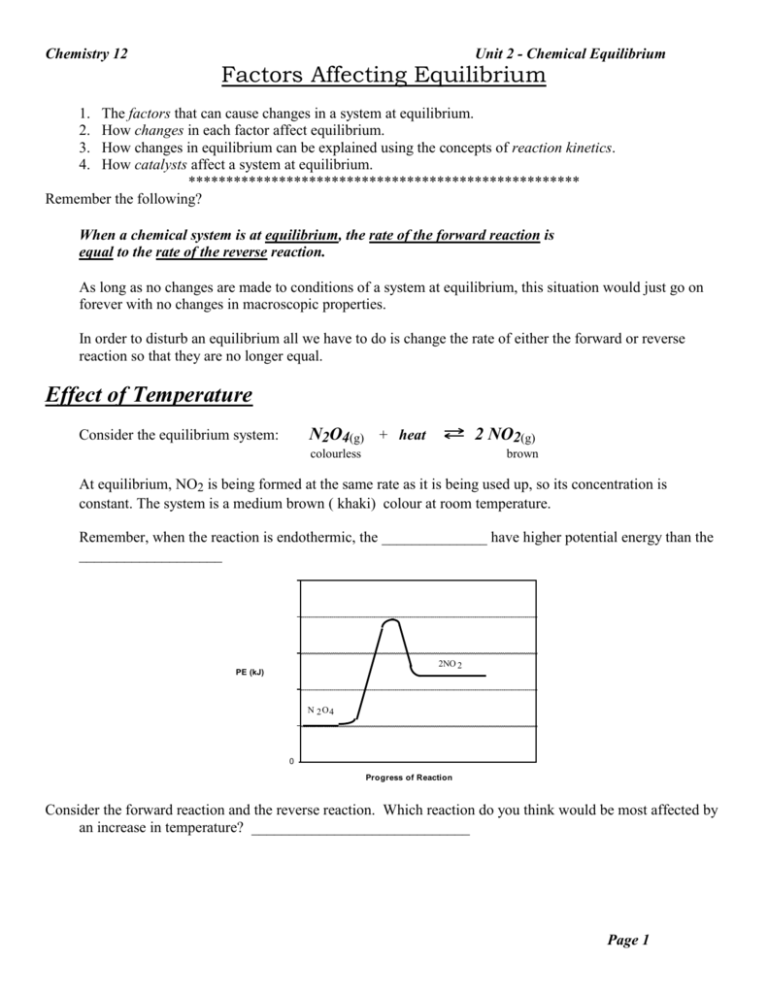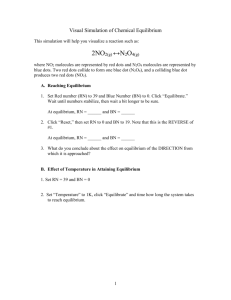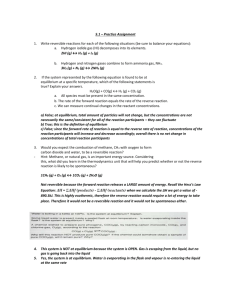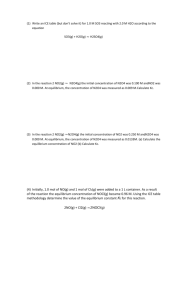Factors Affecting Equilibrium
advertisement

Chemistry 12 Unit 2 - Chemical Equilibrium Factors Affecting Equilibrium 1. 2. 3. 4. The factors that can cause changes in a system at equilibrium. How changes in each factor affect equilibrium. How changes in equilibrium can be explained using the concepts of reaction kinetics. How catalysts affect a system at equilibrium. **************************************************** Remember the following? When a chemical system is at equilibrium, the rate of the forward reaction is equal to the rate of the reverse reaction. As long as no changes are made to conditions of a system at equilibrium, this situation would just go on forever with no changes in macroscopic properties. In order to disturb an equilibrium all we have to do is change the rate of either the forward or reverse reaction so that they are no longer equal. Effect of Temperature N2O4(g) + heat Consider the equilibrium system: 2 NO2(g) colourless brown At equilibrium, NO2 is being formed at the same rate as it is being used up, so its concentration is constant. The system is a medium brown ( khaki) colour at room temperature. Remember, when the reaction is endothermic, the ______________ have higher potential energy than the ___________________ 2NO 2 PE (kJ) N 2O4 0 Progress of Reaction Consider the forward reaction and the reverse reaction. Which reaction do you think would be most affected by an increase in temperature? _____________________________ Page 1 Chemistry 12 Unit 2 - Chemical Equilibrium you will see that increasing the temperature will speed up the forward reaction more than the reverse: One way to look at it is: N2O4(g) + heat 2 NO2(g) In an endothermic reaction, the forward reaction needs heat, so it's rate will be increased more by an increase in temperature. So, increasing the temperature, the forward reaction is faster than the reverse reaction for awhile: (This can be shown by making the forward arrow longer ) N2O4(g) + heat 2 NO2(g) So guess what happens to [NO2] while the forward reaction is faster than the reverse reaction? ________________________________________________________________ N2O4(g) + heat 2 NO2(g) The NO2 is formed faster than it is used up, so it's concentration increases. The N2O4 is used up faster than it is formed, so it's concentration decreases. This might be shown as follows: N2O4(g) + heat 2 NO2(g) Now, since more NO2 has been formed, what do you think will happen to the rate of the Reverse Reaction?_______________________________________________________ Since there are now more molecules of NO2 to run into each other, The rate of the reverse reaction will also speed up. Because there is less N2O4 after awhile, the forward reaction will slow down. So as you might guess, after awhile, the rate of the reverse reaction will again equal the rate of the forward reaction and again we have equilibrium !(a new equilibrium!) But remember this: The forward rate was faster than the reverse rate for awhile.(increasing [NO2] and decreasing [N2O4]) But the reverse rate was never faster than the forward rate even though it finally caught up. Page 2 Chemistry 12 Unit 2 - Chemical Equilibrium It may take a little deep thought about this, but : If NO2 was being formed faster than being used up for awhile but never used up faster than it was being formed, it's concentration will be higher when the new equilibrium is established. With similar thought, you might also see that the [N2O4] will be lower in the new equilibrium. *************************************************************************** N2O4(g) + heat colourless 2 NO2(g) brown When we have more product(s) than we had before and less reactants we say that: The equilibrium has shifted to the right (the stuff on the right has increased and the stuff on the left has decreased) So what will happen to the colour in flask containing the equilibrium mixture when it is put into boiling water and heated? ________________________________________________ ************************************************* If the flask were placed in ice water, the endothermic (forward in this case) reaction would slow down. The rate of the forward reaction is slower than the rate of the reverse reaction.) While the reverse reaction is faster than the forward, the [N2O4] will build up and the [NO2] will decrease... N2O4(g) + heat 2 NO2(g) So what happens now, since [N2O4] is higher, the rate of the forward reaction will gradually increase and after a certain time, it will again be equal to the rate of the reverse reaction. At this point, we have a new equilibrium! In this equilibrium [N2O4] will be higher than it was originally (for awhile it was being formed faster than it was being used up), and the [NO2] will be lower than it was originally.(for awhile it was being used up faster than it was formed.) Page 3 Chemistry 12 To summarize the effect of temperature: Unit 2 - Chemical Equilibrium When the temperature is increased, the endothermic reaction will speed up and the equilibrium will shift toward the side without the heat term. (A new equilibrium is established in which there is a higher concentration of substances on the side without the heat term and a lower concentration of substances on the side with the heat term.) When the temperature is decreased, the endothermic reaction will slow down and the equilibrium will shift toward the side with the heat term. (A new equilibrium is established in which there is a lower concentration of substances on the side without the heat term and a higher concentration of substances on the side with the heat term.) ************************************************** Effect of Concentration and Partial Pressure Next, we will consider what happens when we change the concentration of a reactant or the partial pressure of a reactant. When you have a gas mixture, the pressure exerted by one gas in the mixture is called the partial pressure of that gas. The more of that gas you have, the greater it's partial pressure. For example: In a certain gas mixture containing NO and CO2 gases: Partial Pressure of NO = 40 kPa (kilopascals-a unit of pressure) Partial Pressure of CO2 = 60 kPa Total Pressure = 40 + 60 = 100 kPa If you add some NO, it's partial pressure will go up. For example: Partial Pressure of NO = 50 kPa (kilopascals-a unit of pressure) Partial Pressure of CO2 = 60 kPa Total Pressure = 50 + 60 = 110 kPa Since a higher partial pressure results from putting more of a certain gas in the same volume, it is really just another way of saying concentration. But when one goes up, the other goes up. From now on, when we mention "Partial Pressure" changes, they will have exactly the same effect as Concentration changes. Page 4 Chemistry 12 Consider the following system at equilibrium: CO2(g) + NO(g) Unit 2 - Chemical Equilibrium CO(g) + NO2(g) Let's, all of a sudden, add some CO2 to the container that contains all of these. (What we are doing is increasing the [CO2] or the partial pressure of CO2.) Since the [CO2], a reactant is now higher, there will be more chances of collision between CO2 and NO, so the forward reaction will speed up. This will cause the [CO] and the [NO2] to increase and the [CO2] and [NO] to decrease CO2(g) + NO(g) CO(g) + NO2(g) Because [CO] and the [NO2] have increased, the rate of the reverse reaction will speed up. When the rate of the reverse reaction is again = the rate of the forward reaction, we will again have equilibrium. (A new equilibrium!) CO2(g) + NO(g) CO(g) + NO2(g) In this new equilibrium, [CO] and [NO2] will be higher than they were originally and [CO2] and [NO] will be lower than they were after we added the CO2. In this case, the equilibrium is said to have shifted to the right. (or shifted to the product side.) NOTE: Remember, we added some CO2. In the new equilibrium [CO2] is less than after we added it, but it doesn't quite go down to the level it was before we added any. [NO] will be quite low because it goes down and we didn't add any. *************************************************** Page 5 Chemistry 12 Unit 2 - Chemical Equilibrium Here's a little question for you to do. 2. Given the equilibruim: CO2(g) + NO(g) CO(g) + NO2(g) Some NO2 is added to the system. The _________________________________________ reaction will speed up. This will cause the [CO2] and the [NO] to ______________________________________ Therefore, after awhile, the rate of the __________________________________ reaction will speed up, and there will be a new equilibrium. Because the rate of the ________________________________ reaction was higher for awhile, in the new equilibrium mixture, the [CO2] and the [NO] will be ________________ than they were before and the [CO] and the [NO2] will be __________________________ than after we added the NO2. We can say that adding the NO2 shifted the equilibrium to the _______________________ ************************************************* Page 6 Chemistry 12 Unit 2 - Chemical Equilibrium Effects of Changing the Volume of the Container or Total Pressure As the volume of a fixed number of moles of gas is decreased (the gas is compressed), the pressure will increase. So, to summarize: The greater the number of moles (or molecules) of gas in a particular volume, the greater the pressure. ******************************************************** 2NO2(g) brown N2O4(g) colourless Let's say we have this system in a syringe and we quickly decrease the volume by pushing the plunger in. Recall that decreasing the volume is exactly the same thing as increasing the pressure. Initially, the colour will go darker because everything (including the brown NO2) is compressed. However, when you increase the pressure on something, there is a natural tendency for the system to do anything it can in order to offset that increase. (For example, when you squish a balloon in one place, the air will be forced to another place and the balloon will bulge somewhere else, or the balloon will pop to decrease the pressure!) When we increase the pressure on the 2NO2(g) N2O4(g) system, it can offset that increase by: converting more NO2 into N2O4 ! in other words: shifting to the side with less moles of gas. (as shown by the coefficients) This "shift to the right" will use up some brown NO2 converting it to colourless N2O4, and the colour of the system will gradually get lighter again. So, in summary: When the total pressure is increased (volume is decreased) in an equilibrium system with gases, the equilibrium will shift toward the side with less moles of gas in the equation. or, as you might guess: When the total pressure is decreased (volume is increased) in an equilibrium system with gases, the equilibrium will shift toward the side with more moles of gas in the equation. Page 7 Chemistry 12 Now, try the following problem: 3. Given the equilibrium: Unit 2 - Chemical Equilibrium 2C2H6(g) + 7O2(g) 4CO2(g) + 6H2O(g) a) Increasing the total pressure on this system, will cause a shift to the side with _______ moles of gas, which in this case is the __________________ side. b) Decreasing the total pressure on this system, will cause a shift to the side with ______ moles of gas, which in this case is the __________________ side. c) Increasing the total volume on this system (the same as _________________________ the total pressure) will cause a shift to the side with ____________________________ moles of gas, which in this case is the __________________ side. d) Decreasing the total volume on this system (the same as _______________________ the total pressure) will cause a shift to the side with ___________________________ moles of gas, which in this case is the __________________ side. Effect of Catalysts Consider the equilibrium system: N2O4(g) + heat colourless 2 NO2(g) brown Adding a catalyst to this system would decrease the activation energy by providing a different route (or mechanism) for the reaction: (see the Potential Energy Diagram on the next page.) Uncatalyzed Reaction Catalyzed Reaction PE (kJ) 2NO 2 N 2 O4 0 Using a catalyst to provide a route will decrease the activation energy for the forward reaction and for the reverse reaction by the same amount. Page 8 Chemistry 12 Unit 2 - Chemical Equilibrium This means the forward reaction will speed up, but so will the reverse reaction. In fact, the rates of both the forward and reverse reactions will still remain equal to each other (even though they are both faster.) Therefore, the equilibrium will not shift! Adding a catalyst to a system not at equilibrium will simply speed things up so that equilibrium will be attained faster. It does not alter any of the concentrations etc. at equilibrium! To summarize, equilibrium is affected by: 1. Temperature - If the temp. is increased, the equilibrium will shift toward the side without the heat term. -If the temp. is decreased the equilibrium will shift toward the side with the heat term. 2. Concentration - If the [a reactant] is increased, the equilibrium will shift toward the right (the product side) - If the [a product] is increased, the equilibrium will shift toward the left (the reactant side) 3. Partial Pressure of Gases - the same effects as concentration. 4. Total Volume and Total Pressure - If pressure is increased (volume decreased), the equilibrium will shift to the side with less moles of gas. - If the pressure is decreased (volume increased), the equilibrium will shift toward the side with more moles of gas. 5. Catalysts - Have no effect on equilibrium. They may help a system reach equilibrium faster, that's all! Page 9 Chemistry 12 Unit 2 - Chemical Equilibrium Self-Test on Tutorial 3 1. When a chemical system is at equilibrium, when the temperature is increased, the ___________othermic reaction speeds up the most. 2. In the reaction: A + B C + 43.3 kJ a) When the temperature is increased the (forward/reverse)____________________________ reaction speeds up more. b) During this time, the [A] and [B] will _________crease and the [C] will ________crease. c) Because [A] and [B] are __________creasing, the rate of the ____________________ reaction will increase. d) Sooner or later, the forward rate and the reverse rate will again become _____________. At this point a new ___________________________________ is established. e) In the new equilibrium, [A] and [B] will be _________________er than they were before the temperature is increased. In the new equilibrium, [C] will be _____________________er than it was before. f) In this example, we say that the equilibrium has shifted to the ____________________ 3. Given the reaction: A + B C + 43.3 kJ a) When the temperature is decreased the (forward/reverse)____________________________ reaction will be the faster one. b) During this time, the [A] and [B] will ________crease and the [C] will _________crease. c) Because [C] is ____________creasing, the rate of the __________________________ reaction will increase. d) Sooner or later, the forward rate and the reverse rate will again become _____________. At this point a new ___________________________________ is established. e) In the new equilibrium, [A] and [B] will be __________________er than they were before the temperature is increased. In the new equilibrium, [C] will be _____________________er than it was before. f) In this example, we say that the equilibrium has shifted to the ____________________ Page 10 Chemistry 12 4. In the reaction: Unit 2 - Chemical Equilibrium A + B + 324 kJ C a) When the temperature is increased the (forward/reverse)____________reaction speeds up more. b) During this time, the [A] and [B] will ________crease and the [C] will _________crease. c) Because [C] is __________creasing, the rate of the ____________reaction will increase. d) Sooner or later, the forward rate and the reverse rate will again become _____________. At this point a new __________________ is established. e) In the new equilibrium, [A] and [B] will be _____________er than they were the temperature is increased. before In the new equilibrium, [C] will be _______________er than it was before. f) In this example, we say that the equilibrium has shifted to the ____________________ 5. Given the equilibrium: B(g) + C(g) D(g) + E(g) + heat a) Some B is added to the mixture at equilibrium. The rate of the reaction will increase due to the increase in the [B]. ________________ b) While this is happening, the [D] and [E] will gradually ___________crease. c) The ______crease in the [D] and [E] will cause the rate of the ____________________ reaction to increase. d) When the rates of the forward and reverse reactions are equal, we have a new ____________________________________Due to the addition of B, the equilibrium will shift to the _____________________ [B] and [C] will ___________crease and [D] and [E] will _____________crease 6. Given the equilibrium: B(g) + C(g) D(g) + E(g) + heat a) Some D is added to the mixture at equilibrium. The rate of the ____________________ reaction will increase due to the increase in the [D]. b) While this is happening, the [B] and [C] will gradually ________crease. c) The ______crease in the [B] and [C] will cause the rate of the ___________________ reaction to increase. d) When the rates of the forward and reverse reactions are equal, we have a new _____________________________________________________________________ e) Due to the addition of D, the equilibrium will shift to the _________________________ [B] and [C] will ____________crease and [D] and [E] will __________________crease. Page 11 Chemistry 12 7. Given the equilibrium: Unit 2 - Chemical Equilibrium 2A(g) + B(g) 2C(g) a) If the total pressure on the system is increased, the _____________________________ reaction will speed up the most. b) While this is happening, the [C] will ____________crease. c) This ________crease in [C] will cause the _________________________reaction to speed up. d) When the new equilibrium is reached, the [A] and [B] will be ___________________er than before and the [C] will be ______________________________ than before. e) We say that the increase in total pressure has caused the equilibrium to shift to the ____. 8. Given the equilibrium: 2A(g) + B(g) 2C(g) a) If the total pressure on the system is decreased, the _____________________________ reaction will be the faster one. b) While this is happening, the [A] and the [B] will ___________crease. c) This _______crease in [A] and the [B] will cause the _______________reaction to speed up. d) When the new equilibrium is reached, the [A] and [B] will be ________________er than before and the [C] will be ________________ than before. e) We say that the decrease in total pressure has caused the equilibrium to shift to the ____ 9. Given the equilibrium : NO(g) + CO2(g) NO2(g) + CO(g) a) Will an increase in total pressure have an affect on the equilibrium?________________ b) Explain your answer to question (a)__________________________________________ Page 12 Chemistry 12 10. Unit 2 - Chemical Equilibrium Given the equilibrium: 2A(g) + B(g) 2C(g) a) If the total volume of the system is decreased, the ______________________________ will increase, and the ______________________________reaction will be the faster one. b) While this is happening, the [C] will _______________crease. c) This ________crease in [C] will cause the ___________________reaction to speed up. d) When the new equilibrium is reached, the [A] and [B] will be _______________er than before and the [C] will be _________________ than before. e) We say that the decrease in total volume has caused the equilibrium to shift to the _____ 11. Given the equilibrium: 2A(g) + B(g) 2C(g) + heat a) How will this equilibrium be affected if a catalyst is added to the mixture? __________ _____________________________________________________________________ b) Explain your answer to "a" in terms of forward and reverse reaction rates ____________ _____________________________________________________________________ _____________________________________________________________________ Page 13








